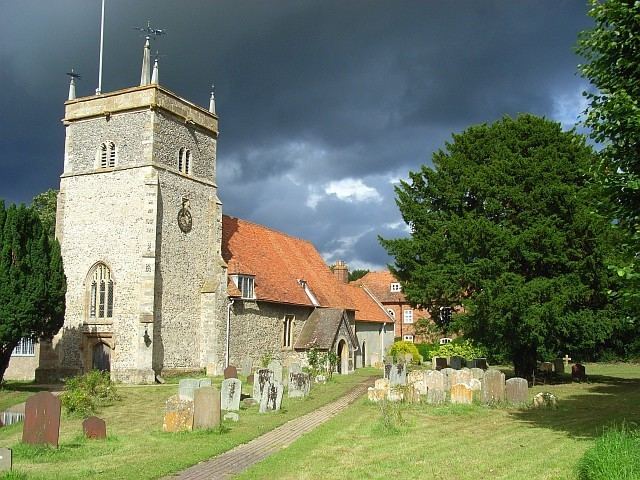OS grid reference SU5570 Local time Sunday 11:42 PM | Civil parish Bucklebury Area 21.82 km² | |
 | ||
Population 2,116 (parish in 2011 census) Weather 6°C, Wind W at 23 km/h, 82% Humidity | ||
Bucklebury berkshire
Bucklebury is a village and civil parish in West Berkshire, England. The village is about 5 miles (8 km) north-east of Newbury and ranges between 1 and 3 miles north of the A4 road. The parish has a population of 2,116 but the village is much smaller. Bucklebury Common is just over 1 square kilometre (0.39 sq mi) and is one of the major village commons in the ceremonial and historic county of Berkshire.
Contents
- Bucklebury berkshire
- Map of Bucklebury Reading UK
- Bucklebury village des middleton en bullition
- Geography
- History
- Parish church
- Ministry and worship
- In literature
- Notable residents
- References
Map of Bucklebury, Reading, UK
Bucklebury village des middleton en bullition
Geography
The parish of Bucklebury has three main parts. The original village is on the banks of the River Pang close to its three sources in the parish. Directly south of Bucklebury village, and on higher ground, is Bucklebury Common, which is 826 acres (334 ha) 3.3 square kilometres (1.3 sq mi) of open grazing on managed heather and woodland. The common is, under the Inclosure Acts, open to villagers only as commoners and privately owned. At the eastern boundary of the common is Chapel Row, incorporating local landmarks such as the Blade Bone public house, a doctors' surgery and a teashop.
The village of Upper Bucklebury became the parish's largest residential area in the late 20th century. This is on a hill about a 1.5 miles (2.4 km) south-west of Bucklebury village at the western tip of the common. Upper Bucklebury has a general store, a public house, a modern Church of England church (dedicated to All Saints), and a Church of England primary school.
The hamlet of Marlston is also in the parish. It is mostly fields, with a large minority of woodland.
History
Bucklebury was a royal manor owned by Edward the Confessor (reigned 1042–66). The village and parish church are recorded in the Domesday Book of 1086. Henry I (reigned 1100–35) granted Bucklebury to the Cluniac Reading Abbey, which retained it until it surrendered all its lands to the Crown in the Dissolution of the Monasteries in 1540.
The place-name 'Bucklebury' is first attested in the Domesday Book of 1086, where it appears as Borgeldeberie, which means 'Burghild's fortified place or borough' ('Burghild' is a woman's name).
Bucklebury has a number of country homes and estates with listed building status, including Bucklebury Manor, a Georgian mansion on Pease Hill.
Wooden bowl-making was "still carried on" in 1923 on or next to Bucklebury Common using its wood.
In the Second World War much of Bucklebury Common was cleared for the stationing of troops. Some of the concrete paths laid down still remain and are now used as bridleways.
Parish church
The Church of England parish church of Saint Mary the Virgin is of consistent style to have been that built in the second half of the 11th century. The ornate south doorway is late Norman and was added in about 1170. A north transept was added to the nave at the end of the 12th or beginning of the 13th century. Late in the 13th century a second arch was added to turn the transept into a two-bay north aisle. One of the windows in the south wall of the nave was added in the 14th century.
In the 15th century the nave and north aisle were lengthened westwards by the addition of a third bay, and new east and two new north windows were inserted in the north aisle. In the second half of the 15th century the Perpendicular Gothic bell tower was added. The chancel was rebuilt in 1591 and the porch was added in 1603. The chancel was partly rebuilt again in 1705 and the porch has also been rebuilt. A vestry has also been added. The whole structure is nationally listed for heritage/architecture in the highest category, Grade I.
The Rectory has an early 18th-century facade. In 1966 the garden included two sculptures by Henry Moore: Draped Reclining Woman 1957–58 and Reclining Figure (1961–62).
Ministry and worship
The ecclesiastical parish has very similar boundaries to the civil (secular) parish and gives its name to a benefice of three churches, which reaches into two parishes to the east to provide six churches each with their own style of worship and architecture. A late December carol service and separate Christmas Eve and Christmas Day communions are held. 2bsd is the collective name for the churches of Bucklebury, Bradfield and Stanford Dingley. The parishes of Bucklebury with Marlston, Bradfield and Stanford Dingley are a group of rural parishes with six very different church buildings, each with its own congregation and distinct styles of worship.
In literature
In Tolkien's legendarium 'Bucklebury Ferry' is run by Buckland Hobbits to Bucklebury, their main town, across the Brandywine river.
